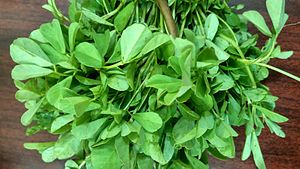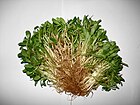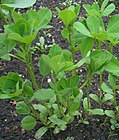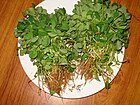Note: This is a project under development. The articles on this wiki are just being initiated and broadly incomplete. You can Help creating new pages.
Difference between revisions of "Trigonella foenum-graecum - Medhika"
m (Prabhakar moved page Medhika (Trigonella foenum-graecum) to Trigonella foenum-graecum - Medhika) |
|||
| Line 1: | Line 1: | ||
[[File:Aesthetic bunch of fenugreek greens.jpg|thumb|right|''Fenugreek'', ''Medhika'']] | [[File:Aesthetic bunch of fenugreek greens.jpg|thumb|right|''Fenugreek'', ''Medhika'']] | ||
| − | '' | + | '''Trigonella foenum-graecum''' is an annual plant in the family Fabaceae, with leaves consisting of three small obovate to oblong leaflets. It is cultivated worldwide as a semiarid crop, and its seeds are a common ingredient in dishes from the Indian subcontinent. It's leaves and seeds of medhika plant are widely used in Indian cuisine. |
| − | == | + | ==Uses== |
| + | {{Uses|Diabetes}}, {{Uses|Constipation}}, {{Uses|greasy stools}}, {{Uses|Loss of appetite}}, {{Uses|SGastroesophageal Reflux Disease}}, {{Uses|Peptic Ulcers}}, {{Uses|Intestinal Gas}}, {{Uses|Flatulence}}, {{Uses|Abdominal Distension}}, {{Uses|Colon Cancer}}, {{Uses|Flatulence}}. | ||
| + | |||
| + | ==Parts Used== | ||
| + | {{Parts Used|Leaves}}, {{Parts Used|Seeds}}. | ||
| + | |||
| + | ==Chemical Composition== | ||
| + | Foenum-graecum leaf is used as a green, leafy vegetable and is a good source of calcium, iron, β-carotene and several vitamins<ref name="chemical composition"/> | ||
| + | |||
| + | ==Common names== | ||
| + | {{Common names|kn=|ml=|sa=|ta=|te=|hi=|en=Agrimony}} | ||
| + | |||
| + | ==Properties== | ||
| + | Reference: Dravya - Substance, Rasa - Taste, Guna - Qualities, Veerya - Potency, Vipaka - Post-digesion effect, Karma - Pharmacological activity, Prabhava - Therepeutics. | ||
| + | ===Dravya=== | ||
| + | |||
| + | ===Rasa=== | ||
| + | Tikta (Bitter), Kashaya (Astringent) | ||
| + | ===Guna=== | ||
| + | Laghu (Light), Ruksha (Dry), Tikshna (Sharp) | ||
| + | ===Veerya=== | ||
| + | Ushna (Hot) | ||
| + | ===Vipaka=== | ||
| + | Katu (Pungent) | ||
| + | ===Karma=== | ||
| + | Kapha, Vata | ||
| + | ===Prabhava=== | ||
| + | |||
| + | ==Habit== | ||
| + | {{Habit|Herb}} | ||
| + | |||
| + | ==Identification== | ||
| + | ===Leaf=== | ||
| + | {{Leaf|Simple|alternate|The leaves are alternate, compound, trifoliolate, 7-12 cm long, light green in colour}}<ref name="Leaf"/> | ||
| + | |||
| + | ===Flower=== | ||
| + | {{Flower|Unisexual|2-4cm long|Blue|5-20|The flowers are papillonaceous, borne in leaf axils, white, lemon-yellow or purplish blue in colour}} | ||
| + | |||
| + | ===Fruit=== | ||
| + | {{Fruit|Oblong|2-10 cm|The fruits occur as straight or sickle-like pods of 2-10 cm|green-olive or brownish in colour|10-20 seeds}} | ||
| + | |||
| + | ===Other features=== | ||
| + | |||
| + | ==List of Ayurvedic medicine in which the herb is used== | ||
| + | * [[Vishatinduka Taila]] as ''root juice extract'' | ||
| + | |||
| + | ==Where to get the saplings== | ||
| + | ==Mode of Propagation== | ||
| + | {{Propagation|Seeds}}, {{Propagation|Cuttings}}. | ||
| + | |||
| + | ==How to plant/cultivate== | ||
| + | Succeeds in ordinary garden soil, preferring a well-drained loamy soil in full sun. Requires a warm, sheltered position in Britain<ref name="How to plant/cultivate"/> | ||
| + | |||
| + | ==Commonly seen growing in areas== | ||
| + | {{Commonly seen|Field verges}}, {{Commonly seen|Uncultivated ground}}, {{Commonly seen|dry grasslands}}. | ||
| + | |||
| + | ==Photo Gallery== | ||
| + | <gallery class="left" caption="" widths="140px" heights="140px"> | ||
| + | Fresly sprouted Qasuri Methi.JPG | ||
| − | + | Junger Bockshornklee.jpg | |
| − | + | ||
| + | Qasuri Methi.JPG | ||
| − | |||
| − | |||
| − | |||
| − | |||
| − | |||
| − | |||
| − | + | Aesthetic bunch of fenugreek greens.jpg | |
| − | + | ||
| − | + | Arznei- und Giftgewächse (No. 70-71) BHL7773168.jpg | |
| − | |||
| − | |||
| − | <references> | + | Dried leaves of Fenugreek-Kasuri Methi.jpg |
| − | <ref name=" | + | |
| − | <ref name=" | + | |
| + | Fenugreek - ഉലുവ.JPG | ||
| + | |||
| + | |||
| + | Fenugreek leafs.JPG | ||
| + | |||
| + | </gallery> | ||
| + | |||
| + | ==References== | ||
| + | |||
| + | <references> | ||
| + | <ref name="chemical composition">[http://scienceinternational.com/fulltext/?doi=sciintl.2013.194.198 "Chemical compounds"]</ref> | ||
| + | |||
| + | <ref name="Leaf">[https://www.feedipedia.org/node/242 "plant description"]</ref> | ||
| + | |||
| + | <ref name="How to plant/cultivate">[https://www.pfaf.org/user/Plant.aspx?LatinName=Trigonella+foenum-graecum "Cultivation details"]</ref> | ||
</references> | </references> | ||
| − | == External Links == | + | ==External Links== |
| − | + | * [https://www.sciencedirect.com/science/article/pii/S1878535214000677 Trigonella foenum-graecum on science direct.com] | |
| − | *[https:// | + | * [https://www.ncbi.nlm.nih.gov/pubmed/16381462 Study on chemical constituents in total saponin from Trigonella foenum-graecum] |
| − | *[ | + | * [https://plantvillage.psu.edu/topics/fenugreek/infos Trigonella foenum-graecum on plantvillage.psu.education] |
| + | * [https://www.botanical-online.com/english/fenugreek_plant.htm Trigonella foenum-graecum on botanical-online.com] | ||
[[Category:Herbs]] | [[Category:Herbs]] | ||
Revision as of 15:32, 12 June 2018
Trigonella foenum-graecum is an annual plant in the family Fabaceae, with leaves consisting of three small obovate to oblong leaflets. It is cultivated worldwide as a semiarid crop, and its seeds are a common ingredient in dishes from the Indian subcontinent. It's leaves and seeds of medhika plant are widely used in Indian cuisine.
Contents
- 1 Uses
- 2 Parts Used
- 3 Chemical Composition
- 4 Common names
- 5 Properties
- 6 Habit
- 7 Identification
- 8 List of Ayurvedic medicine in which the herb is used
- 9 Where to get the saplings
- 10 Mode of Propagation
- 11 How to plant/cultivate
- 12 Commonly seen growing in areas
- 13 Photo Gallery
- 14 References
- 15 External Links
Uses
Diabetes, Constipation, greasy stools, Loss of appetite, SGastroesophageal Reflux Disease, Peptic Ulcers, Intestinal Gas, Flatulence, Abdominal Distension, Colon Cancer, Flatulence.
Parts Used
Chemical Composition
Foenum-graecum leaf is used as a green, leafy vegetable and is a good source of calcium, iron, β-carotene and several vitamins[1]
Common names
| Language | Common name |
|---|---|
| Kannada | |
| Hindi | |
| Malayalam | |
| Tamil | |
| Telugu | |
| Marathi | NA |
| Gujarathi | NA |
| Punjabi | NA |
| Kashmiri | NA |
| Sanskrit | |
| English | Agrimony |
Properties
Reference: Dravya - Substance, Rasa - Taste, Guna - Qualities, Veerya - Potency, Vipaka - Post-digesion effect, Karma - Pharmacological activity, Prabhava - Therepeutics.
Dravya
Rasa
Tikta (Bitter), Kashaya (Astringent)
Guna
Laghu (Light), Ruksha (Dry), Tikshna (Sharp)
Veerya
Ushna (Hot)
Vipaka
Katu (Pungent)
Karma
Kapha, Vata
Prabhava
Habit
Identification
Leaf
| Kind | Shape | Feature |
|---|---|---|
| Simple | alternate | The leaves are alternate, compound, trifoliolate, 7-12 cm long, light green in colour |
Flower
| Type | Size | Color and composition | Stamen | More information |
|---|---|---|---|---|
| Unisexual | 2-4cm long | Blue | 5-20 | The flowers are papillonaceous, borne in leaf axils, white, lemon-yellow or purplish blue in colour |
Fruit
| Type | Size | Mass | Appearance | Seeds | More information |
|---|---|---|---|---|---|
| Oblong | 2-10 cm | The fruits occur as straight or sickle-like pods of 2-10 cm | green-olive or brownish in colour | 10-20 seeds | {{{6}}} |
Other features
List of Ayurvedic medicine in which the herb is used
- Vishatinduka Taila as root juice extract
Where to get the saplings
Mode of Propagation
How to plant/cultivate
Succeeds in ordinary garden soil, preferring a well-drained loamy soil in full sun. Requires a warm, sheltered position in Britain[3]
Commonly seen growing in areas
Field verges, Uncultivated ground, dry grasslands.
Photo Gallery
References
External Links
- Ayurvedic Herbs known to be helpful to treat Diabetes
- Ayurvedic Herbs known to be helpful to treat Constipation
- Ayurvedic Herbs known to be helpful to treat greasy stools
- Ayurvedic Herbs known to be helpful to treat Loss of appetite
- Ayurvedic Herbs known to be helpful to treat SGastroesophageal Reflux Disease
- Ayurvedic Herbs known to be helpful to treat Peptic Ulcers
- Ayurvedic Herbs known to be helpful to treat Intestinal Gas
- Ayurvedic Herbs known to be helpful to treat Flatulence
- Ayurvedic Herbs known to be helpful to treat Abdominal Distension
- Ayurvedic Herbs known to be helpful to treat Colon Cancer
- Herbs with Leaves used in medicine
- Herbs with Seeds used in medicine
- Herbs with common name in English
- Habit - Herb
- Index of Plants which can be propagated by Seeds
- Index of Plants which can be propagated by Cuttings
- Herbs that are commonly seen in the region of Field verges
- Herbs that are commonly seen in the region of Uncultivated ground
- Herbs that are commonly seen in the region of dry grasslands
- Herbs








